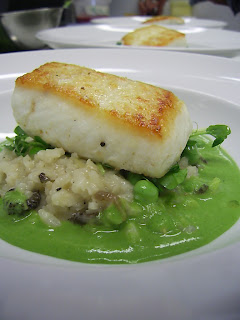
To continue on with the theme of organ meats, sweetbreads found their way onto the plate today. Not nearly as often as I'd have liked, but they did make it onto the plate a couple of times.
I'm not sure what it is about sweetbreads that makes people squeamish, but something does. Perhaps someone out there can let me know what it is. All I know is that we almost sold out of liver but we could barely sell a sweetbread. For any of you lucky enough to have eaten sweetbreads I know that you would order them again. I have never met a single person who has tried a sweetbread and then said they didn't like it. Everything about them is fantastic.
So, what is a sweetbread. Well, it is one of two things. It can be a thyroid glad which is found in the throat, or it can be a thymus gland, which is found beside the heart. The heart glands are said to be a better product and therefore cost a bit more. I really don't see to much of a difference between the two. The glads are used to help fight alongside their brothers in the war for immunities. Veal and lamb are the most common form which you will find, for as the animals age, the gland begin to disappear. The pinker or redder the gland, the older the animal.
First things first. I soaked the sweetbreads in a brine overnight. The following day i poached them in milk and herbs for about 6 minutes to firm them up, then plunged them into an ice bath to stop any further cooking. Once cooled I peeled of the outer membrane, then pressed them between two pans with weights on top to press out any excess moisture. They are now ready to cook. Many people will bread them and then deep fry them. A great way to have them. The most common way is to dust them with flour and then pan fry them. I, along with many others, see no reason to dust them in flour. They pan fry beautifully on their own, why add the flour, I find that a lot of the time they become pasty if flour is used.
I served this along with a sautee of parmesan gnocchi, local apricots and basil. A roasted local eggplant and smoked paprika puree. Finally, some balsamic jus to bring it all together.
This was most likely one of the tastiest lunch specials I've made all season and we only sold 4 on a day when I cooked lunch for 197 people. There are a lot of people who missed out on this one. Sweetbreads will make an appearance again in the near future, I'll promise you that. However, I think that I'll have to use them as a small component and then work my way up from there. The Okanagan has a lot to learn about food before it can become the mecca that it deserves to be.

Sean Peltier









 PEROGIES!!
PEROGIES!! 






































